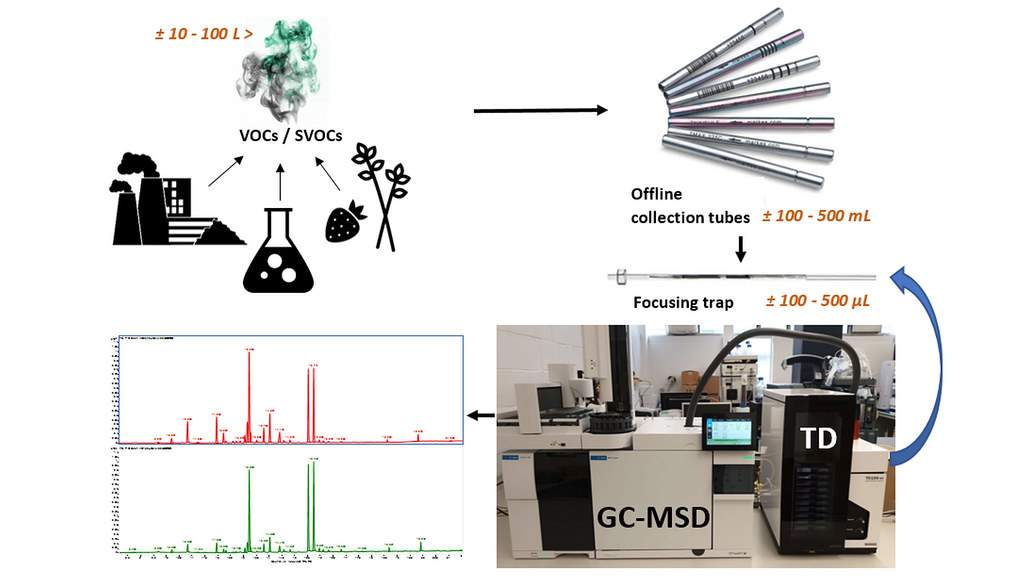The repertoire of mass spectrometry instruments in MC² has been expanded by the addition of a gas chromatography mass selective detector (GC-MSD) interfaced with an automated thermal desorption (TD) unit. The instrument will be primarily utilised for monitoring of volatile organic compounds as markers of indoor air quality, as well as conventional GC compatible samples (e.g. volatile, non-polar compounds).
Volatile organic compounds (VOC), semi-volatile organic compounds (SVOC), and very volatile organic compounds (VVOC) refers to any of thousands of organic chemicals that are present as gases at room temperature. VOCs and SVOCs are atmospheric pollutants that can have adverse effects on human health, some of which are known carcinogens. VOC examples include alcohols (cleaning reagents), benzene (petroleum fuel, tobacco smoke), alkanes and alkynes (lubricants) and terpenes (paint and glue). SVOC examples include polycyclic aromatic hydrocarbons (fuel combustion), brominated flame retardants and phthalate esters (consumer products), as well as organochlorine pesticides and pyrethroids (agriculture, insect repellents).
| Description | Abbreviation | Boiling point range (°C) | Example compounds |
|---|---|---|---|
| Very volatile (gaseous) organic compounds | VVOC | <0 to 50-100 | Propane, butane, methyl chloride |
| Volatile organic compounds | VOC | 50-100 to 240-260 | Formaldehyde, d-Limonene, toluene, acetone, ethanol (ethyl alcohol) 2-propanol (isopropyl alcohol), hexanal |
| Semi volatile organic compounds | SVOC | 240-260 to 380-400 | Pesticides (DDT, chlordane, plasticizers (phthalates), fire retardants (PCBs, PBB) |
Adapted from Ref 1. Classification as defined by the World Health Organization (WHO)
Analysis of different VOC classes can be problematic due to their relative low levels of occurrence at sub parts-per-billion (PPB) levels, often in complex mixtures. Thermal desorption (TD) is a very effective technique to up-concentrate these low-level analytes and is therefore often used to monitor a wide range of sample matrices, including environmental monitoring of indoor and outdoor air, water, soil, as well as aroma-profiling in food and drink. The TD analysis is a two-stage process, firstly off-line collecting and concentration of organic vapours from samples onto sorbent-packed collection tubes takes place, after which the compounds are passed on to a secondary focusing trap inside a TD autosampler unit using carrier gas. The secondary trap is then rapidly heated to desorb and pass the volatiles onto the GC column for separation. Large sample volumes, containing a range of target VOCs, are therefore repeatedly extracted/desorbed into smaller volumes of gas, resulting in up to 106-fold up concentration, ultimately improving sensitivity and enabling trace-level analysis of target compounds.
Benefits of Thermal Desorption as compared to solvent extraction:
- Efficient extraction – as gas is continuously purging compounds from the sorbent/trap typical desorption, therefore efficiencies of 95% are observed with good reproducibility.
- Minimal sample handling – manual sample preparation is minimised, obviating the need to work with toxic or odorous extraction solvents, and limiting introduction of interfering compounds from pipettes or solvents.
A multitude of versatile configurations/collection sampling methods helps to enable analysis of both liquid- and solid-phase samples. Conventional methods for sampling onto sorbent tubes includes passive diffusion and active pumping of sampled atmosphere. Sorbent tubes can also be coupled to thermogravimetric analysis (TGA) equipment to allow for the collection of evolved gases during sample heating. Experiments can even be conducted in heated chambers (µ-chambers) specifically designed to collect vapours from samples such as leather, car trim plastics, herbs and spices, and kids’ toys, all with the aim of determining what volatile organic compounds are given off by these materials under different environmental conditions.
Absolute quantitation of VOCs can be achieved by injecting authentic gas or liquid standards onto sorbent tubes, allowing for the response factors to be compared with the sample analytes to determine absolute amounts. Moreover, MS/MS spectra can be compared to commercially available fragmentation libraries, such as the National Institute of Standards and Technology (NIST) database, to help identify unknowns. Desorption from the sorbent tubes previously meant only one-shot analyses could be performed, however this shortcoming has been addressed by recollecting vapours from the trap back onto the original or blank sorbent tube, allowing multiple desorption of the same collected sample for multiple analyses using different methods.
In summary, TD-GC-MS is a reliable analytical approach to facilitate sensitive, accurate and reproducible analysis of a wide range of SVOCs, VOCs and VVOCs.
References
1. Technical Overview of Volatile Organic Compounds, https://www.epa.gov/indoor-air-quality-iaq/technical-overview-volatile-organic-compounds, accessed 6th April 2020.

